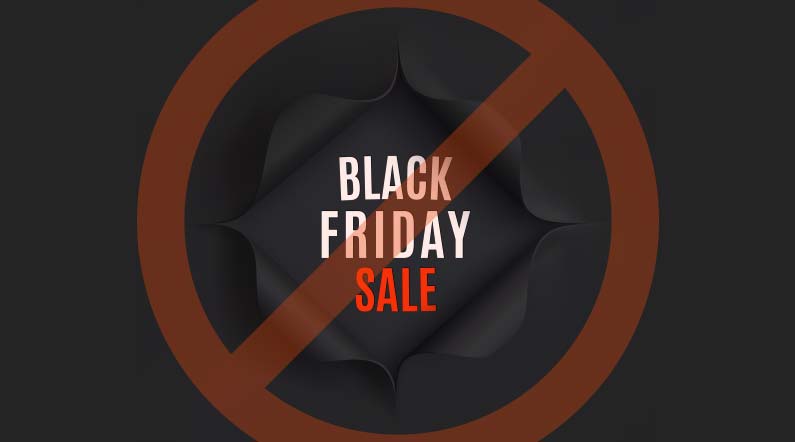It’s been a long time coming – the redefinition of Black Friday. Since retailers started opening on Thanksgiving, the air has gone out of Black Friday. Last year, the Black Friday weekend was a bust with flat sales and fewer consumers out shopping on Friday. Why? Retailer marketers have done it to themselves. They began opening on Thanksgiving Day, which reduced the reason to go out early Friday morning and they started to advertise “Black Friday” specials earlier and earlier…in some cases in July! No wonder consumers are confused. Can American retailers officially declare Black Friday dead?
Still Too Much At Stake
It’s hard to kill Black Friday. The holiday shopping season represents 20-30% of most retailers’ annual sales. This year, the National Retail Federation estimates sales of over $630 billion, of which online sales will make up $105 billion (or 16%). This represents 3.7% growth and more than $805 in spending per person on gifts, decorations and holiday food. Moreover, with low gas prices, a strengthening job market and a modest growth in wages, retailers have their fingers crossed.
Last year nearly 90 million people went shopping on Black Friday. For decades, retailers have conditioned consumers to be ready to shop at 4 AM for “door buster specials”. Retailers made Black Friday a series of complex hurdles where it was a version of “Survivor”. If you watch any of the online videos, Black Friday shopping can be seen as a competitive contact sport! However, is this the shopping experience retailers are trying to foster during what is supposed to be a cheery season?
For retailers, they’re normally in a sprint at this time of year. There are 29 shopping days between Thanksgiving and Christmas Eve and they have to squeeze the most revenue out of each day. They’ve learned two things…consumers still like to go shopping during this period and consumers are using technology to facilitate their shopping.
Change the Brand Experience
For the first time, large retailers like Wal-Mart and Target are rethinking the consumer shopping experience to make it kinder and gentler. Wal-Mart for instance will reduce their reliance on door buster specials and make deals available in-store and online beginning Thanksgiving Day. They’ve cleaned up stores and have much larger inventories of key promotional items so that they take the stress out of trying to get everything done in one day of shopping. Some stores, like Best Buy, are making Black Friday deals available earlier both online and in-store.
Importantly, however, retailers need consumers to continue to come into the store. And for them having the brick and mortar presence has some big advantages as there are two consumer needs that are difficult to fill either online or on a mobile device…the impulse purchase and self-gifting.
This year, to enhance the shopping experience, marketers are also rolling out promotions and tools that are designed to make shopping easier and more engaging for their consumers:
- They are bundling store gift cards with high value promotional items like TV’s, tablets, appliances, etc. The gift cards, ranging from $50-200 will hopefully encourage self-gifting and additional spending. Last year 77% of shoppers purchased a gift for themselves over the Black Friday weekend.
- Providing rainchecks for sold out items (to reduce frustration)
- Offering free shipping with no minimums (whether purchased online or instore)
- Offering price matching – to reduce the risk of shoppers leaving the store without making a purchase
- Since 50% of consumers use the internet to research purchases, most retailers have completely revamped their commerce websites and mobile apps to make buying easier (e.g., provide reviews, etc.) and more effectively drive consumers to the store
- They are even “leaking” Black Friday sale items one or two weeks ahead of time to drive excitement and help consumers plan their shopping strategy.
The goal is to make holiday shopping a more pleasant and engaging experience. Black Friday, the day, has already morphed into a “Black Friday” concept – starting in early November not requiring consumers to stake everything on a single day. Since the recession, consumer behavior has changed so they’re purchasing more holiday gifts throughout the year. Over 40% of consumers have made holiday gift purchases before October 1st.
As we discussed in our last blog, big box retailers opened Pandora’s Box by opening on Thanksgiving. However, in competing against Amazon, the one key advantage they have is their shopping experience. If they can create a better shopping experience and remove the artificial hurdles they created on Black Friday, they might be on to something and to give their brands a boost.
Maybe the new “Black Friday” experience will be embraced by consumers as a positive less frantic way to do their Holiday shopping. Retailers are sure banking on it…long live Black Friday!
See our interview about Black Friday on KUSI
KUSI News – San Diego, CA


Recent Comments